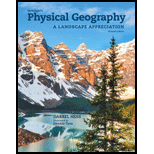
The similarities and differences of highland ice fields and continental ice sheets.
Answer to Problem 1LC
Both highland ice fields and continental ice sheets are continuous covers of glacial ice; The difference between them are that the highland ice fields are found only in high-elevated mountain regions, and are much smaller in surface area than continental ice sheets. The continental ice sheets are several meters deep and wide that develop over the non-mountainous areas of the continents such as Greenland and Antarctica.
Explanation of Solution
Highland ice field:
A highland icefield is an unconfined ice sheet accumulation in a high-mountainous region that extends a few hundred or few thousand square kilometers. It encloses all the underlying topography except for some protruding pinnacles called “nunataks”. These highland icefields are significant in portion of the high country of western Canada and southern Alaska and on various islands of the Arctic, specifically Iceland.
Continental ice sheets:
A massive blanket of ice that completely engulfs the landmass underneath to about hundreds or thousands of meters depth. The depth of the ice sheets are greater in its interior and thins out at the outer edges. These are formed in non-mountainous areas of continents. There are only two true ice sheets currently, in Antarctica and Greenland.
Want to see more full solutions like this?
Chapter 19 Solutions
McKnight's Physical Geography: A Landscape Appreciation
- 72 ic 18 The planets 1 Can you find eleven Solar System words in the grid? e E W b V e n a e P r r + h C i - PU 0 0 n c e t S c e r P W n P i t e r U 6 r f U n - K σ г m a r S n W e t Y g n d r e E C Y O P U S t a r > S a t U r n 2 Rearrange the letters into the names of the planets. a ucerr My c un Ves e hrtEa g sarM b ruepitj d rntSau f uneNtep_ h nasu Urarrow_forwardAnswer the photoarrow_forwardwhat are your thoughts on the critical importance of soil management and its impact on agricultural productivity and environmental health, and role of conservation tillage. write in first personarrow_forward
- Five arguments that the Water Bottle Bill was passed as a means of "revenue" enhancement In developing your arguments you should start at the website of the Connecticut State Library which contains the history of all legislation passed by the Connecticut Legislature http://ctstatelibrary.org/leghistory_ to gather the information for your arguments. use referencesarrow_forwardDescribe the importance of recycling household solid wastesarrow_forwardWhy is food waste a growing concern? Describe how some communities are addressing the food waste issue.arrow_forward
- How does Gateway Community College or Norwalk, CT deal with solid waste? Can solid waste production be limited at your institution or city? How? What barriers exist that might make it difficult to limit solid waste production?arrow_forwardIt is possible to have a high standard of living, as in North America and Western Europe, and not produce large amounts of solid waste. How?arrow_forwardHow is lifestyle related to the quantity of municipal solid waste generated?arrow_forward
 Applications and Investigations in Earth Science ...Earth ScienceISBN:9780134746241Author:Edward J. Tarbuck, Frederick K. Lutgens, Dennis G. TasaPublisher:PEARSON
Applications and Investigations in Earth Science ...Earth ScienceISBN:9780134746241Author:Edward J. Tarbuck, Frederick K. Lutgens, Dennis G. TasaPublisher:PEARSON Exercises for Weather & Climate (9th Edition)Earth ScienceISBN:9780134041360Author:Greg CarbonePublisher:PEARSON
Exercises for Weather & Climate (9th Edition)Earth ScienceISBN:9780134041360Author:Greg CarbonePublisher:PEARSON Environmental ScienceEarth ScienceISBN:9781260153125Author:William P Cunningham Prof., Mary Ann Cunningham ProfessorPublisher:McGraw-Hill Education
Environmental ScienceEarth ScienceISBN:9781260153125Author:William P Cunningham Prof., Mary Ann Cunningham ProfessorPublisher:McGraw-Hill Education Earth Science (15th Edition)Earth ScienceISBN:9780134543536Author:Edward J. Tarbuck, Frederick K. Lutgens, Dennis G. TasaPublisher:PEARSON
Earth Science (15th Edition)Earth ScienceISBN:9780134543536Author:Edward J. Tarbuck, Frederick K. Lutgens, Dennis G. TasaPublisher:PEARSON Environmental Science (MindTap Course List)Earth ScienceISBN:9781337569613Author:G. Tyler Miller, Scott SpoolmanPublisher:Cengage Learning
Environmental Science (MindTap Course List)Earth ScienceISBN:9781337569613Author:G. Tyler Miller, Scott SpoolmanPublisher:Cengage Learning Physical GeologyEarth ScienceISBN:9781259916823Author:Plummer, Charles C., CARLSON, Diane H., Hammersley, LisaPublisher:Mcgraw-hill Education,
Physical GeologyEarth ScienceISBN:9781259916823Author:Plummer, Charles C., CARLSON, Diane H., Hammersley, LisaPublisher:Mcgraw-hill Education,





